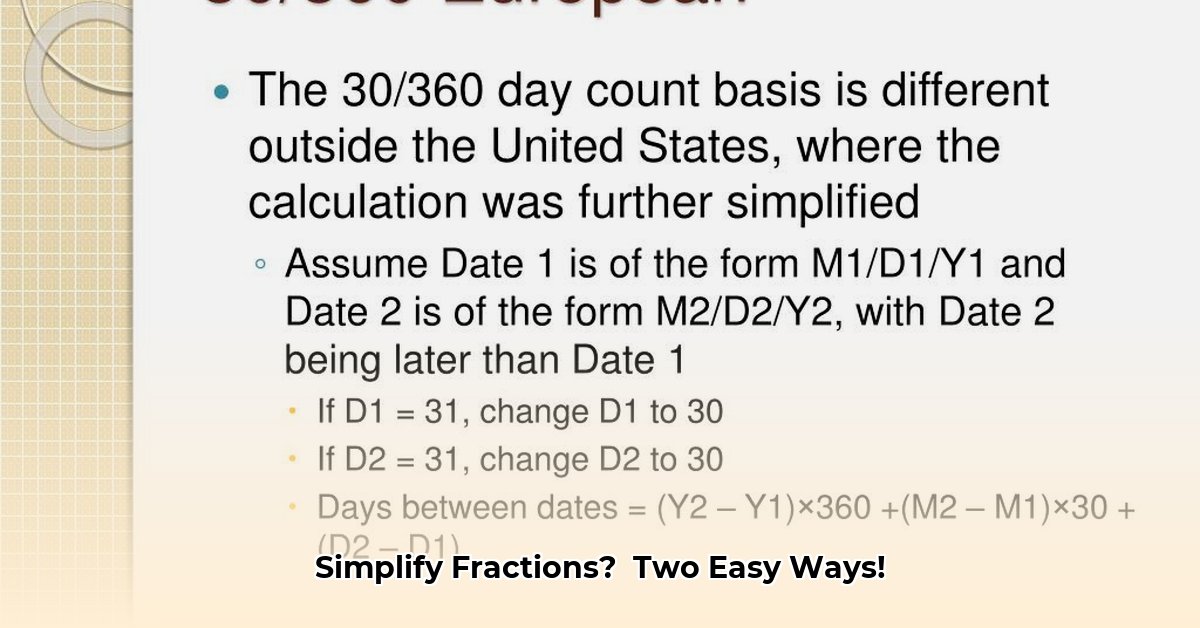
Fractions can seem daunting, but simplifying them is a crucial skill in mathematics. This guide provides two straightforward methods for simplifying fractions, using the example of 30/360. Whether you're a student, teacher, or anyone working with fractions, these methods will empower you to reduce fractions with confidence. We'll cover the Greatest Common Factor (GCF) method and the Prime Factorization method, clarifying their strengths and weaknesses.
Method 1: The Greatest Common Factor (GCF) Method
This method involves finding the largest number that divides evenly into both the numerator (top number) and the denominator (bottom number) of the fraction. This number is called the Greatest Common Factor (GCF), or sometimes the Greatest Common Divisor (GCD).
Let's simplify 30/360 using the GCF method:
Identify the GCF: Observe that 30 is a divisor of both 30 and 360 (360 ÷ 30 = 12). Therefore, the GCF of 30 and 360 is 30.
Divide by the GCF: Divide both the numerator and the denominator by the GCF (30):
Numerator: 30 ÷ 30 = 1
Denominator: 360 ÷ 30 = 12
Simplified Fraction: The simplified fraction is 1/12.
This method is quick and efficient when the GCF is easily identifiable. However, finding the GCF can be challenging for larger numbers, potentially requiring trial and error. Is there a quicker method for more complex scenarios? Let's explore another approach.
Method 2: The Prime Factorization Method
This method breaks down the numerator and the denominator into their prime factors—numbers divisible only by 1 and themselves (e.g., 2, 3, 5, 7, 11...). This provides a systematic approach, especially useful for larger numbers where the GCF isn't immediately obvious.
Let's simplify 30/360 using prime factorization:
Find Prime Factors: Determine the prime factors of both the numerator and denominator:
30 = 2 × 3 × 5
360 = 2 × 2 × 2 × 3 × 3 × 5
Identify Common Factors: Identify the prime factors common to both 30 and 360: 2, 3, and 5.
Cancel Common Factors: Cancel out the common factors. This is equivalent to dividing both the numerator and denominator by the product of the common factors (2 x 3 x 5 = 30).
Simplified Fraction: The remaining factors form the simplified fraction: 1/12.
This method offers a structured approach, particularly beneficial for larger or less intuitive fractions. How does it compare to the GCF method in terms of efficiency? Let's delve into a comparative analysis.
Comparing the Two Methods
Both the GCF and prime factorization methods achieve the same result—simplifying the fraction to its lowest terms. However, their efficiency varies depending on the numbers involved.
| Method | Advantages | Disadvantages |
|---|---|---|
| Greatest Common Factor (GCF) | Quick and efficient for smaller numbers when the GCF is easily recognized. | Can be challenging to find the GCF for larger numbers; involves trial and error. |
| Prime Factorization | Systematic and effective for both smaller and larger numbers; builds number sense. | Can be more time-consuming than the GCF method for smaller, simpler fractions. |
The choice of method depends on the specific fraction and individual preference. For smaller numbers, the GCF method can be faster. For larger or more complex fractions, prime factorization's systematic nature offers a more reliable path to simplification. Mastering both methods gives you a versatile toolkit for handling any fraction simplification task effectively. For 30/360, both methods consistently lead to the simplified fraction 1/12.
Key Takeaways:
- Both the GCF and prime factorization methods effectively simplify fractions to their lowest terms.
- The GCF method is faster for smaller fractions with readily identifiable GCFs.
- Prime factorization offers a systematic approach, especially beneficial for larger or more complex fractions.
- Proficiency in both methods provides broader mathematical problem-solving skills.